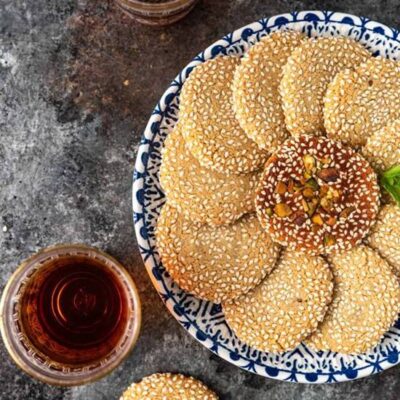Barazek or barazeq (in Arabic barāzeq) is a classic Syrian-Palestinian cookie whose main ingredient is sesame (also called simsim and baksum in Arabic) and often also contains pieces of pistachio. Barazek is a typically Syrian culinary specialty, rooted in Damascus, the country’s capital. These cookies are popular in Homs or in Aleppo, a city located in the north-west of Syria and famous for its production of tasty pistachios. Although the barazek is originally a Syrian pastry, the recipe has spread widely throughout the Middle East, including Lebanon and Jordan. It is now common to find the famous sesame biscuits throughout the Levantine area (Lebanon, Israel, Jordan, Palestine and Syria) and beyond. It is one of the more traditional Palestinian desserts and it is easy to find stalls selling barazek on the streets of Jerusalem. Make it as big or as small as you want, crunchy or chewy depends on the thickness you form them, so these cookies can easily be tailored to your liking. For many Syrians, barazek is a sweet treat synonymous with exchange, conviviality and community spirit. They can be enjoyed throughout the year, accompanied by a cup of mint tea, black tea (preferably full-bodied) or a delicious Armenian coffee.
------Advertisement-----
Portions of this story was originally published in the Los Angeles Times by Charles Perry on April 18, 2007:
LOS ANGELES — The other day, a co-worker brought in some mysterious cookies from an Armenian bakery, a little sheepish about having polished off about a third of them on the way. They were tan domes with a tight spiral pattern on top, making them look a bit like snail shells lying on their sides. The pastry had a distinctive taste, more wholesome than cookie dough, followed by a little blast of richness from that spiral, which turned out to be a filling of sesame tahini. It tasted like peanut butter without peanut butter’s funky edge.
------Advertisement-----
In other words, these were cookies we could eat a lot of, and we proceeded to do so. But not before I saved one or two to explore their mystery. When you cut one in half, the interior turned out to be curving lines of pastry alternating with darker caverns of sesame filling, vaguely like the pattern of layers in a halved onion. Whatever it was, the pastry was definitely not cookie dough. I had to know what was going on here.
This plunged me into the vortex of the 70-odd Armenian bakeries in the L.A. area. Some were bread bakeries, but a lot were filled with case after case of French patisserie and syrup-soaked baklavas — dangerous places to wander around in. Only a couple of pastry shops made these tahini cookies. But how did this innocent cookie end up in these glittering palaces of seduction anyway?
------Advertisement-----
It turned out that this “cookie” is considered to be a bread — not a pastry — because it’s made with yeast-risen dough. It happens to be a clever variation on Middle Eastern tahini bread (in Arabic, khubz tahini; in Armenian, tahinov hats), which is usually made as a pita-size flatbread. Some Armenian bakeries, such as Taron in east Hollywood, make this big, flat variety, but Maral’s Pastry in Van Nuys and Sarkis Pastry in Glendale make the dome-cookie version.

